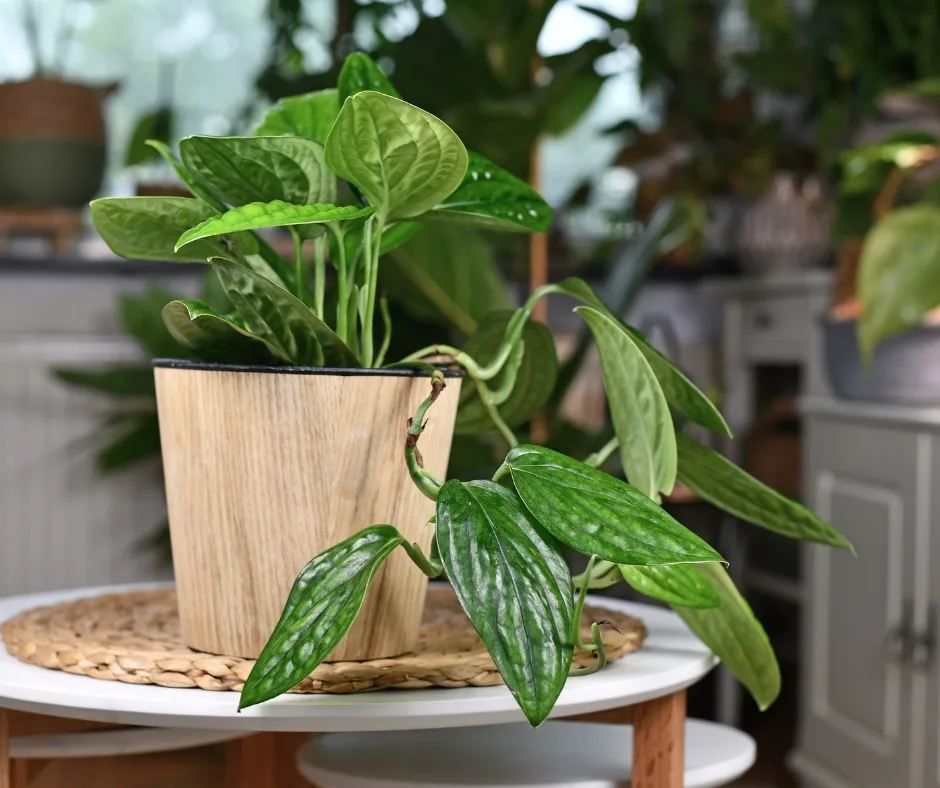The Monstera Peru is a vining houseplant with glossy green textured leaves. This plant is popular among houseplant enthusiasts.
This plant grows in a vining pattern as a hemi-epiphyte it will vine onto another plant for support and grow onto trees. When kept as a houseplant, it’s best to train this plant onto a moss pole or trellis so it can climb while it grows. The Monstera Peru also grows quite quickly making it a stunning plant to keep in your home.

This plant will prefer a light and quick draining medium to be potted in. Monstera roots can get choked and rot in compact soil. A loose and well draining soil will also allow you a little breathing room in the watering schedule.
The Monstera Karstenianum will be happiest in a bright indirect light spot in your home. Keep it somewhere with filtered sunlight, and it will grow quickly.
The care for this plant is very simple and straightforward. It is very similar to the Monstera Adansonii and the Monstera Siltepecana the monstera plant genus is a family of 45 different species.

The Monstera Peru can be difficult to locate in local stores and nurseries. You can get lucky and run across them occasionally at a nursery or greenhouse. This plant is readily available online, you can purchase them from Etsy where many small business owners propagate and sell cuttings and plants.
Keep this plant away from children and pets. It is considered toxic and could cause fatal reactions if ingested.
Easy to care for plants:



We have compiled a simple to read easy printable care guide below.

Monstera Peru Care Guide

The Monstera Peru is a semi rare houseplant with gorgeous textured leaves that grows in a vining pattern.
This plant also comes in a rare variegated leaf form!
This Care Guide will teach you how to keep this houseplant happy all through the year.
Materials
- Orchid bark
- Peat moss
- Perlite
- General potting soil
- mask
- Fertilizer
Tools
- Pot (ceramic, plastic, or terra cotta)
- Potting medium (perlite, soil, peat moss, and orchid bark)
- Scissors
- Rubbing Alcohol
Instructions
Soil Preference:
- Monstera Peru prefer well draining soil. The roots will rot quickly if they sit in moist soil.
- A homemade aroid soil mix of 1/2 potting soil and 1/2 peat moss or coco fiber is a good mix for monsteras
- Make sure your pot has drainage at the bottom. Do not use a pot with no drainage hole for this plant.
- A heavy soil potting mix is not recommended for Monsteras
Pot Size and Type:
- The monstera peru can grow in many different kinds of pots, I like to plant mine in terra cotta pots with a drainage hole.
- Repot every second year or when roots come out the drainage holes on the pot bottom. Don't jump to a huge pot from a small one. Just go to the next size up pot.
Lighting:
- The Monstera Peru will be happiest in moderate indirect light. It will also grow just fine in lower light conditions, but the growth will be slower.
- Some filtered sunlight from a window may be appreciated in this circumstance.
- Make sure the Monstera Peru isn't sitting in constant direct sunlight. The leaves can burn.
Watering:
- Water your monstera when the soil is dry at least an inch down. These aroid plants are typically drought resistant and can withstand longer periods of dryness compared to other houseplants. Every two weeks should be fine.
- Watering is best done on a regular schedule so the plant is not over or under watered. Both can cause stress on the plant.
- In dormant winter months reduce watering to when the soil is dry.
- Never let this plant get wet feet. This plant is susceptible to root rot and fungus gnats in heavy moist soils.
How to Fertilize:
- Apply a good quality fertilizer (linked in materials) monthly through Spring and summer.
- Decrease feedings by late Fall and allow this plant to rest through the winter months.
Temperature:
- The monstera plant will do best in temperatures between 65-85 degrees F.
Pests:
- The monstera peru is a hardy resilient plant. However all plants can get attacked by pests.
- Stress by longterm overwatering, poor light, extreme temperatures and soil conditions are contributors to plant stress..
- Spider mites, mealy bugs, scale, thrips and whitefly are the most common houseplant pests you will see.
- Read our post on How to get rid of aphids and other pests with our homemade pesticide soap recipe or neems oil.
- To minimize the possibility of pests be sure to check all nursery plants before bringing them home.
- Quarantine all new plants until you are sure no pests live in them.
How to Propagate:
- Cut stem in the internodal spacing using sterile scissors
- Choose a stem that is 6-8 inches long with several nodes
- Place in water with nodes down in the water and leaf up
- After several weeks roots will grow
- Plant in soil when roots are 2-3 inches long
Notes
This plant does best when trained onto a pole or trellis so it can climb. Watch the video below of us repotting and staking our raphidophora tetrasperma for tips on repotting climbing aroids.
Follow Us:
Find us on YouTube, Instagram , Pinterest and TikTok! We love to Plant chat. We also comment, like and occasionally share your content to our daily stories. We’d love to see your plants. Share your joy in your houseplants. Happy Planting!


Blue Star Fern Care Guide and Plant Profile - The Contented Plant
Saturday 16th of July 2022
[…] The Monstera Peru […]
Monstera karstenianum (M. Peru) – AZbitki
Friday 15th of July 2022
[…] Monstera karstenianum – Fotoğraf: thecontentedplant.com […]